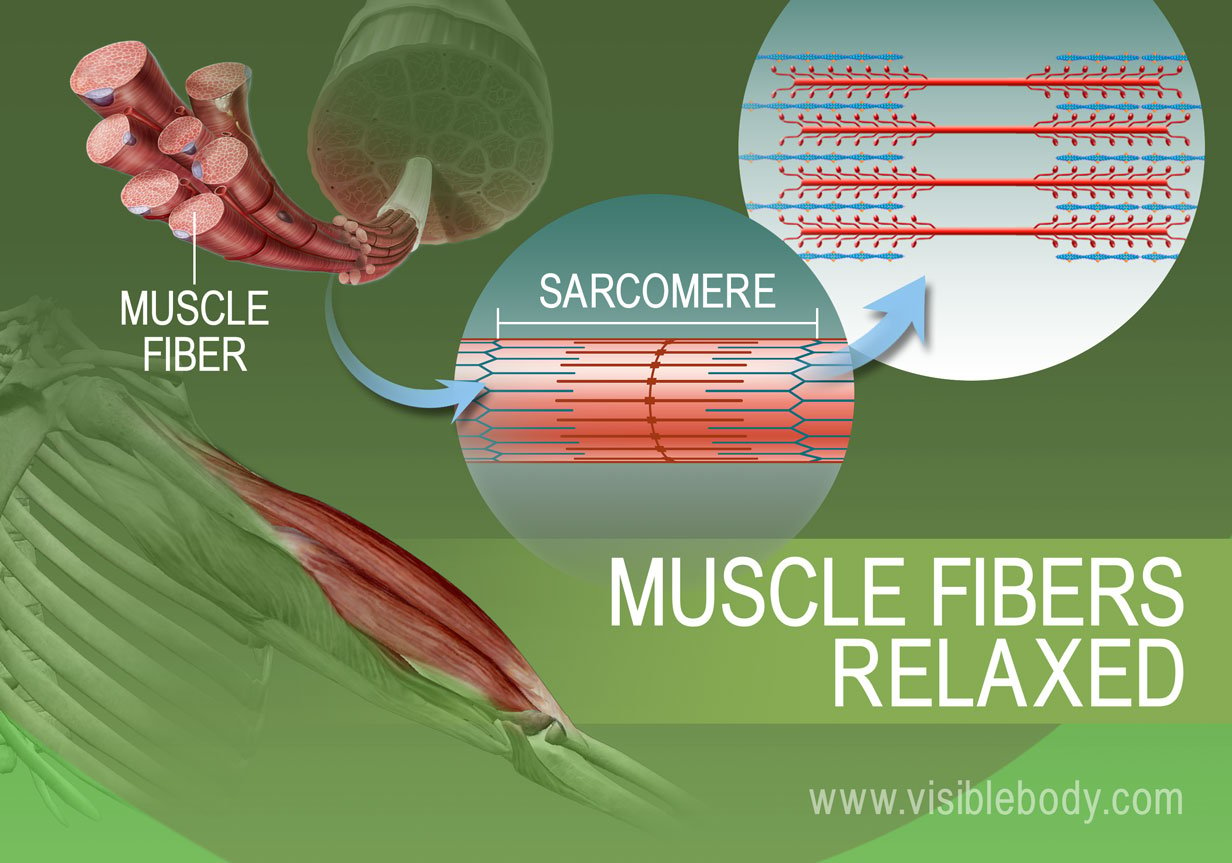Describe How Muscles Contract and Relax.
Usually referred to as Calcium channels. Calcium is released from the terminal cisternae into the muscle fiber.

Muscle Contractions Learn Muscular Anatomy
The release of calcium ions initiates muscle contractions.

. Calcium binds to troponin. This is contraction. Explain how muscles work with tendons to move the body 4.
When a muscle contracts bunches up it gets shorter and so pulls on the bone it is attached to. The muscles are made of long string like structures they are called actin and myosin. Groups of thick and thin filaments that alternately overlap and move apart are called sarcomeres.
It is almost identical to hold-relax except that instead of. But you can make a fist and that is tense -. All muscles are made up of two contractile proteins called actin and myosin.
When the CNS sends a signal the thick and thin myosin filaments form a crossbridge pattern by sliding past each other. The sodium influx also sends a message within the muscle fiber to trigger the release of stored calcium ions. The chemical stimulates muscle relaxation by disconnecting myosin and actin.
One is a head on a spring the other like a saucer. Muscle contraction occurs when the thin actin and thick myosin filaments slide past each other. What are the steps in muscle contraction.
This makes the sarcomeres shorter and thicker contracting the muscle. Describe what is involved in muscle contraction. When relaxation begins the opposing muscle contracts and pulls the original contracting muscle back into place.
Explain how muscles contract and relax. ATP also known as adenosine triphosphate is the primary source of energy. Myosin head groups attach to the surrounding actin filaments forming a cross-bridge.
Muscles can only pull and cannot push. This causes the muscle to stop contracting and begin relaxation. When a muscle contraction occurs a nerve impulse is sent to the neuromuscular junction that causes the release of.
This is the power stroke. During contraction and relaxation the length of. Explain the organization of muscle tissue 2.
Calcium floods into the muscle cell binding with troponin allowing actin and myosin to bind. A muscle may also stop contracting when it runs out of ATP and becomes fatigued. Start studying Unit 3 How Does a Muscle Contract and Relax.
The relative movement of thick and thin filaments causes muscles to contract and relax. Thus myofibrils and muscle cells contract as the sarcomeres contract. It is generally assumed that this process is driven by cross-bridges which extend from the myosin filaments and cyclically interact with the actin filaments as ATP is hydrolysed.
Describe the components involved in a muscle contraction Explain how muscles contract and relax Describe the sliding filament model of muscle contraction The sequence of events that result in the contraction of an individual muscle fiber begins with a signalthe neurotransmitter AChfrom the motor neuron innervating that fiber. The primary mode of action for muscle is by contraction. The actin and myosin cross bridges bind and.
Who are the experts. Ironically ATP is also needed for muscle relaxation. A signal is sent from the brain or.
When they connect - you have a tense muscle. Experts are tested by Chegg as specialists in their subject area. When acetylcholine reaches receptors on the membranes of muscle fibers membrane channels open and the process that contracts a relaxed muscle fibers begins.
The head group then bends causing the think filament to be pulled along and so overlap more with the thick filaments. This stimulates the sarcoplasmic reticulum to release calcium into the muscle cell. A myofibril is composed of many sarcomeres running along its length.
When a muscle relaxes it goes back to its normal size. The areas between the thick and thin filaments during a relaxed state are called I bands H zones and A bands. It can happen when you hold or pick up something or.
Acetylcholine binds with receptors on the cell membrane on the muscle fiber opening Ca2 -Na channels. Muscle Contraction Steps in Detail. Explain how muscles work with tendons to move the body 4.
Another common PNF technique is the contract-relax stretch. Open channels allow an influx of sodium ions into the cytoplasm of the muscle fiber. Groups of actin and myosin form myofibrils which group together to form a muscle fiber which group together to form a fascicle which group together to form the whole muscle.
Ca ions are pumped back into the SR which causes the tropomyosin to reshield the binding sites on the actin strands. Describe the function and structure of skeletal cardiac muscle and smooth muscle 3. Relaxation of a Muscle Fiber.
According to Muscle Physiology from the University of California San Diego ATP supplies the energy needed by muscles to contract. Muscle contraction is the tightening shortening or lengthening of muscles when you do some activity. 100 1 rating Muscle are made up of actin and myosin.
Once your muscle contracts the space between the motor end plate and the fibers releases an enzyme called acetylcholinesterase which ends the stream of action. We review their content and use your feedback to keep the quality high. Describe how muscles contract and relax 5.
The motor nerve stimulates an action potential impulse to pass down a neuron to the neuromuscular junction. The Sliding Filament Model of Contraction When signaled by a motor neuron a skeletal muscle fiber contracts as the thin filaments are pulled and then slide past the thick filaments within the fibers sarcomeres. Define the process of muscle metabolism.
Troponin shifts tropomyosin which was blocking the active site on the actin. Learn vocabulary terms and more with flashcards games and other study tools.

Muscle Fiber Contraction And Relaxation Lifetime Fitness And Wellness

Muscle Contraction And Movement In Animals Body Movements Class 6

Muscle Fiber Contraction And Relaxation Lifetime Fitness And Wellness
No comments for "Describe How Muscles Contract and Relax."
Post a Comment